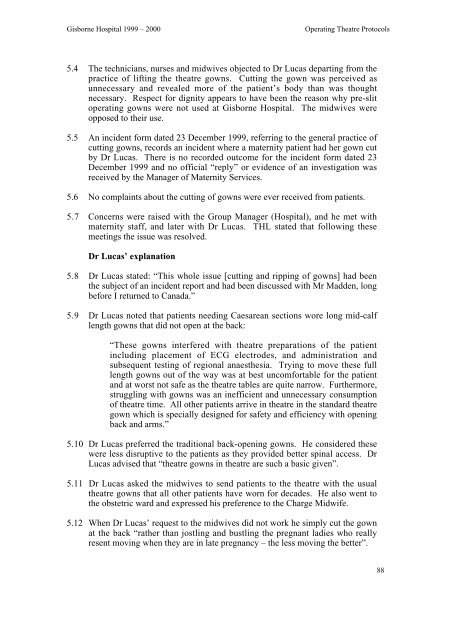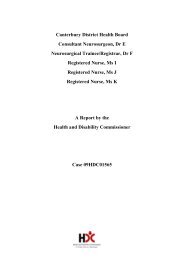Gisborne Hospital Report - Health and Disability Commissioner
Gisborne Hospital Report - Health and Disability Commissioner
Gisborne Hospital Report - Health and Disability Commissioner
You also want an ePaper? Increase the reach of your titles
YUMPU automatically turns print PDFs into web optimized ePapers that Google loves.
<strong>Gisborne</strong> <strong>Hospital</strong> 1999 – 2000<br />
Operating Theatre Protocols<br />
5.4 The technicians, nurses <strong>and</strong> midwives objected to Dr Lucas departing from the<br />
practice of lifting the theatre gowns. Cutting the gown was perceived as<br />
unnecessary <strong>and</strong> revealed more of the patient’s body than was thought<br />
necessary. Respect for dignity appears to have been the reason why pre-slit<br />
operating gowns were not used at <strong>Gisborne</strong> <strong>Hospital</strong>. The midwives were<br />
opposed to their use.<br />
5.5 An incident form dated 23 December 1999, referring to the general practice of<br />
cutting gowns, records an incident where a maternity patient had her gown cut<br />
by Dr Lucas. There is no recorded outcome for the incident form dated 23<br />
December 1999 <strong>and</strong> no official “reply” or evidence of an investigation was<br />
received by the Manager of Maternity Services.<br />
5.6 No complaints about the cutting of gowns were ever received from patients.<br />
5.7 Concerns were raised with the Group Manager (<strong>Hospital</strong>), <strong>and</strong> he met with<br />
maternity staff, <strong>and</strong> later with Dr Lucas. THL stated that following these<br />
meetings the issue was resolved.<br />
Dr Lucas’ explanation<br />
5.8 Dr Lucas stated: “This whole issue [cutting <strong>and</strong> ripping of gowns] had been<br />
the subject of an incident report <strong>and</strong> had been discussed with Mr Madden, long<br />
before I returned to Canada.”<br />
5.9 Dr Lucas noted that patients needing Caesarean sections wore long mid-calf<br />
length gowns that did not open at the back:<br />
“These gowns interfered with theatre preparations of the patient<br />
including placement of ECG electrodes, <strong>and</strong> administration <strong>and</strong><br />
subsequent testing of regional anaesthesia. Trying to move these full<br />
length gowns out of the way was at best uncomfortable for the patient<br />
<strong>and</strong> at worst not safe as the theatre tables are quite narrow. Furthermore,<br />
struggling with gowns was an inefficient <strong>and</strong> unnecessary consumption<br />
of theatre time. All other patients arrive in theatre in the st<strong>and</strong>ard theatre<br />
gown which is specially designed for safety <strong>and</strong> efficiency with opening<br />
back <strong>and</strong> arms.”<br />
5.10 Dr Lucas preferred the traditional back-opening gowns. He considered these<br />
were less disruptive to the patients as they provided better spinal access. Dr<br />
Lucas advised that “theatre gowns in theatre are such a basic given”.<br />
5.11 Dr Lucas asked the midwives to send patients to the theatre with the usual<br />
theatre gowns that all other patients have worn for decades. He also went to<br />
the obstetric ward <strong>and</strong> expressed his preference to the Charge Midwife.<br />
5.12 When Dr Lucas’ request to the midwives did not work he simply cut the gown<br />
at the back “rather than jostling <strong>and</strong> bustling the pregnant ladies who really<br />
resent moving when they are in late pregnancy – the less moving the better”.<br />
88
















